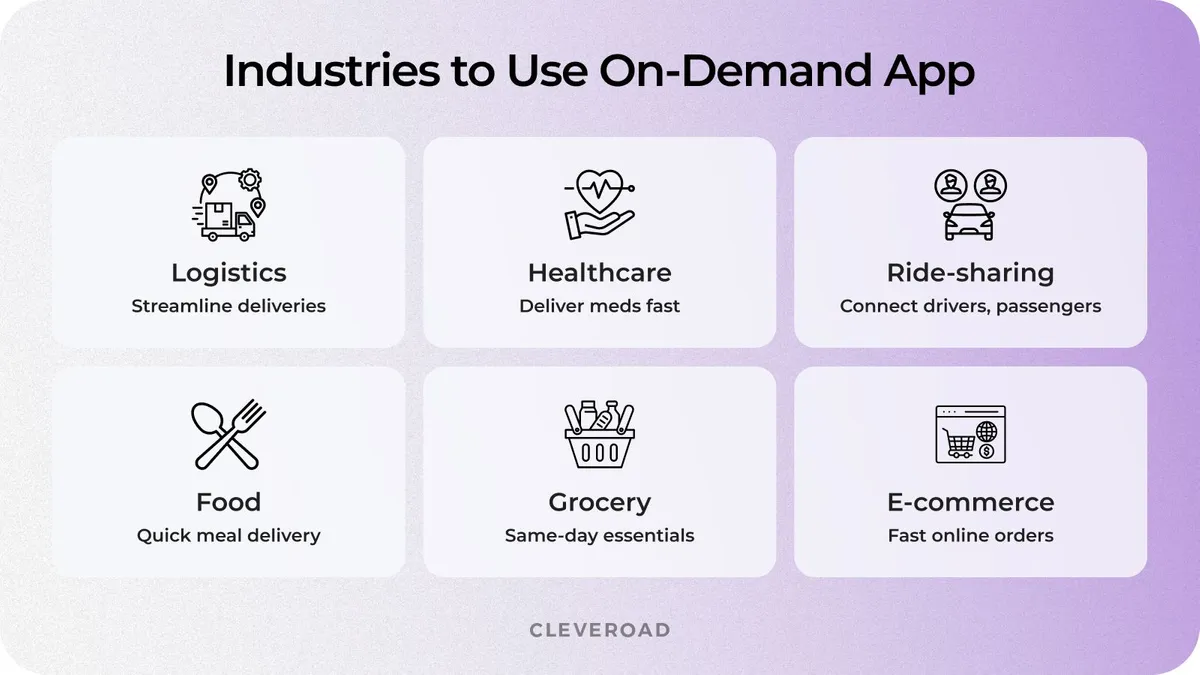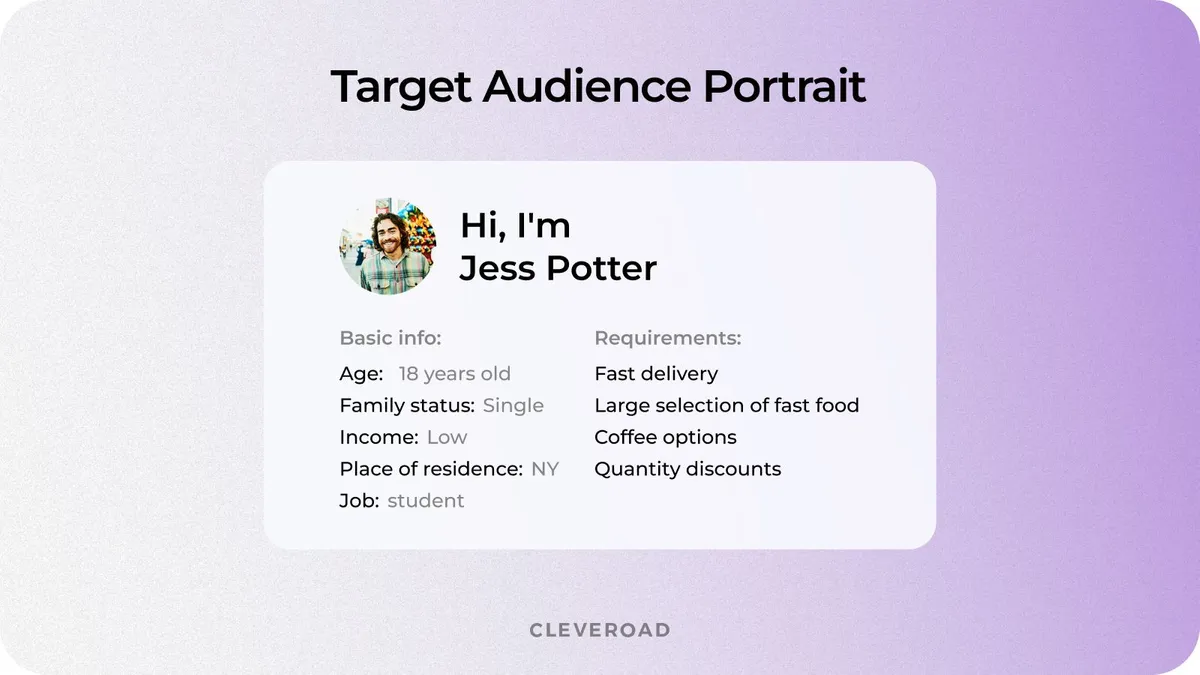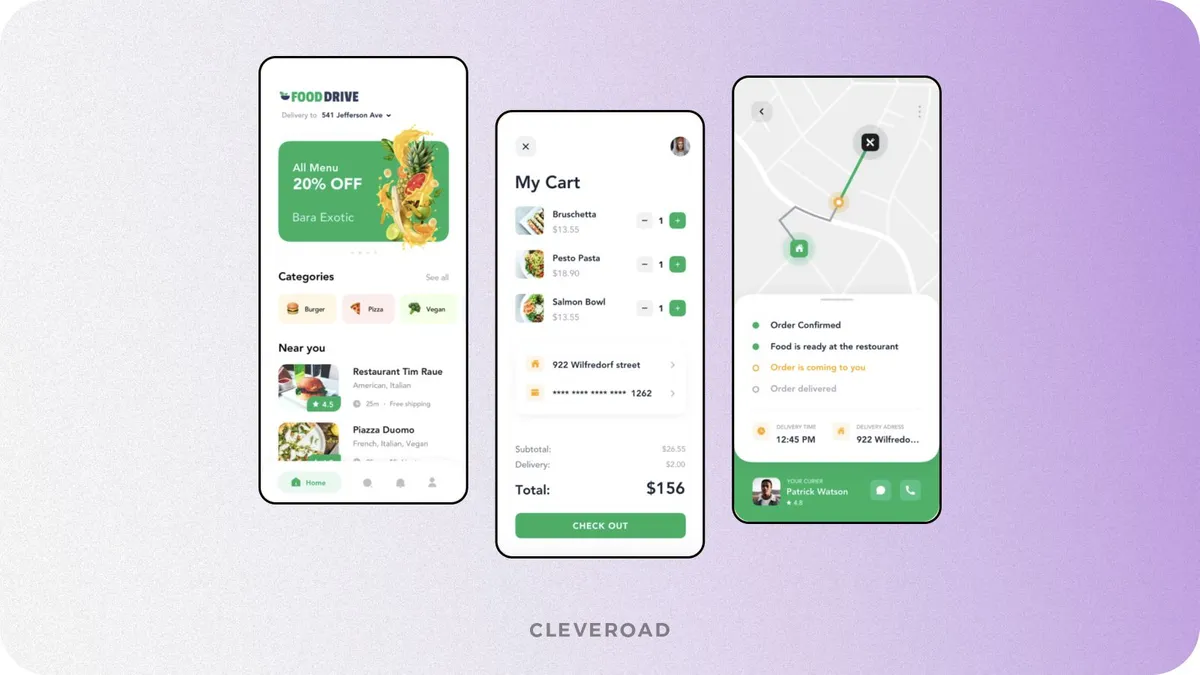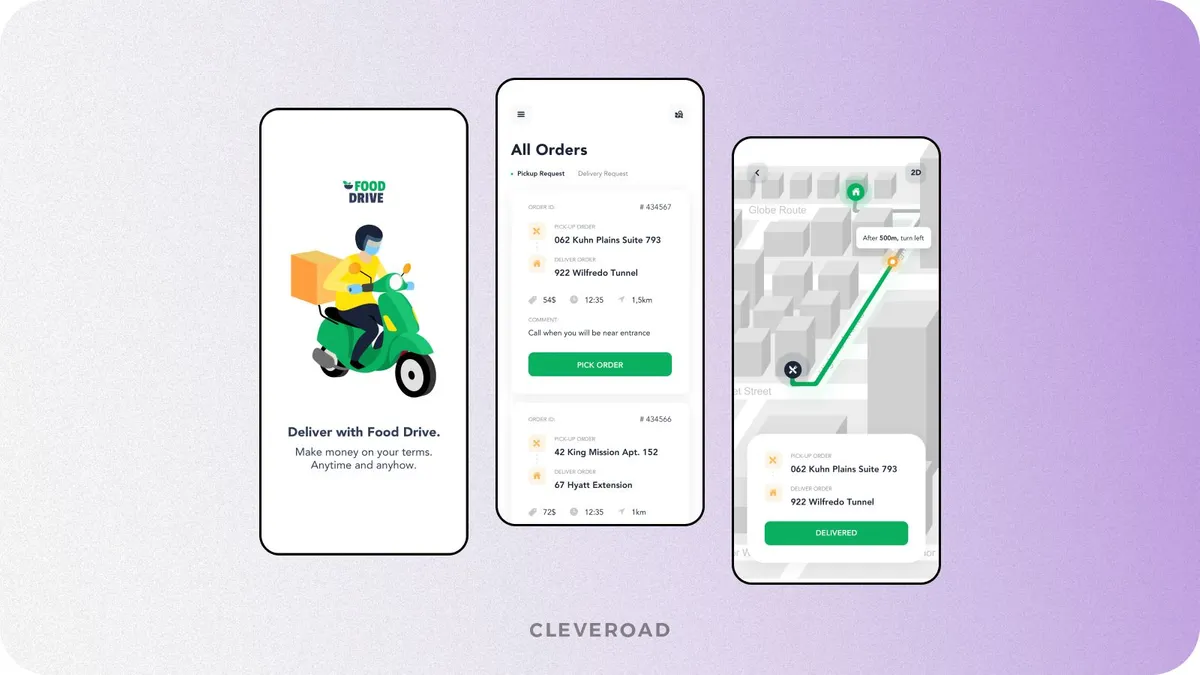On-Demand Delivery App Development: 2025 Step-By-Step Instruction to Succeed
Updated 06 Dec 2024
18 Min
3298 Views
On-demand delivery platform development has become an essential thing for businesses seeking to meet modern customer demands. Industry giants like Uber, Airbnb, and Glovo dominate the market, but many startups, such as Nuro, Deliv, and LogiNext, have also carved out their space in this thriving sector. Developing such an app, however, requires careful planning, time, and financial investment.
This step-by-step guide will walk you through the entire process of creating a delivery app — from validating your idea and identifying must-have features to estimating costs and exploring monetization strategies.
What Is an On-Demand Delivery App?
An on-demand delivery app is a digital solution that connects customers with businesses or service providers to deliver products or services in real-time or within a specified timeframe. These apps cater to industries like food delivery, grocery shopping, courier services, and even healthcare by offering fast, efficient, and user-friendly platforms for transactions.
Let’s explore the key stages of how an on-demand delivery app operates:
- Customer registration. Customers sign up and create a profile within the app.
- Order placement. Then, the users browse available services or products, add them to a cart, and place an order.
- Real-time tracking. Once the order is confirmed, the app enables customers to track their delivery status in real time.
- Payment processing. Secure payment options, including cards, digital wallets, or cash-on-delivery, are integrated into the app.
- Delivery fulfillment. A delivery partner or service provider ensures the order reaches the customer.
This seamless interaction between users, service providers, and delivery agents has made on-demand apps indispensable for both businesses and customers. That’s why on-demand delivery mobile app development is essential for many industries.
Industries to use on-demand delivery apps
On-demand delivery apps have become indispensable across various industries, revolutionizing the way businesses connect with customers. By offering real-time or scheduled delivery services, these apps enhance operational efficiency, improve customer satisfaction, and drive business growth.
Let’s explore the industries that benefit the most from on-demand delivery solutions.
- Logistics and courier services: Streamline parcel deliveries and improve tracking
- Healthcare: Enable fast delivery of medications and medical supplies
- Taxi and ride-sharing services: Connect drivers with passengers in real-time
- Food delivery: Provide quick and convenient meal deliveries
- Grocery delivery: Facilitate shopping and same-day delivery of essentials
- E-commerce and retail: Support quick delivery of online purchases, enhancing customer satisfaction
These apps enhance efficiency, customer convenience, and business growth across diverse sectors. As businesses aim to build on demand delivery apps, they leverage innovative solutions to cater to specific needs, such as food delivery services, which have their own unique types and models.
Understanding the app development process is crucial for creating a successful mobile application that meets user expectations and drives growth. This makes demand app development a key focus for companies seeking to stay competitive in today's market.

Major industries using on-demand delivery apps
Benefits of using an on-demand delivery app
Let's find out what on-demand delivery app development will give your business to succeed.
1. Cost-effectiveness. On-demand delivery apps help businesses reduce operational costs by streamlining processes like order management, dispatch, and tracking. Automation minimizes the need for extensive manual intervention, saving labor expenses. For customers, these apps often provide cost-effective options through competitive pricing and discounts.
2. Convenience and time-saving. These apps prioritize user convenience by offering features like one-tap ordering, scheduled deliveries, and quick payments. For businesses, they simplify operations with automated order processing and inventory updates. Customers save time by avoiding the need to visit stores or arrange deliveries manually.
3. Real-time tracking. It ensures that customers and businesses have full visibility of their orders. Customers can monitor delivery progress and estimated arrival times, enhancing trust and transparency. Businesses benefit by identifying delays early and managing customer expectations.
4. Accessibility. On-demand delivery apps make services and products accessible to a broader audience, including those in remote areas. Their 24/7 availability allows users to place orders at their convenience, breaking the limitations of traditional business hours. For businesses, these apps create opportunities to reach new markets without significant infrastructure investments.
Types of On-Demand Delivery Services
On-demand delivery app development caters to a wide range of needs across industries. Here are the key types, along with examples, standout features, and estimated development costs.
Medicine/equipment delivery solutions
On-demand apps for medicine or equipment delivery are service apps designed to deliver medications or medical equipment directly to patients or healthcare facilities.
- Examples: PillPack, 1mg, Netmeds
- Killer features: Prescription uploads, inventory integration with pharmacies, secure payment options, and HIPAA-compliant data storage
- Estimated development cost: $40,000–$90,000+, depending on regulatory compliance and features
Beauty and wellness platforms
The beauty and wellness applications are intended to bring beauty, grooming, or wellness experts to customers at their preferred location.
- Examples: Glamsquad, Urban Company, StyleSeat
- Killer features: Service provider profiles, appointment scheduling, location-based matching, and in-app reviews
- Estimated development cost: $25,000–$70,000+
Apps for food delivery services
Apps for food delivery services are the on-demand mobile platforms that connect users with restaurants for quick and convenient meal deliveries.
- Examples: Uber Eats, DoorDash, Grubhub
- Killer features: Real-time order tracking, user-friendly menus with filters, multiple payment options, and push notifications for deals and updates
- Estimated development cost: $30,000–$80,000+ for a basic app; $100,000+ for advanced features
How to create a food delivery app? Read our guide and find out!
Platforms for taxi services
The ride-hailing platforms for taxi services are required to match drivers with passengers for real-time or scheduled transportation needs.
- Examples: Uber, Lyft, Bolt
- Killer features: GPS-based ride matching, fare calculation, in-app payment, driver ratings, etc.
- Estimated development cost: $40,000–$100,000+ depending on complexity and scale
Cargo delivery apps
Cargo delivery apps are tailored for logistics and freight transport, enabling businesses and individuals to manage and track cargo shipments, making them a key part of delivery platform development.
- Examples: Lalamove, GoShare, Trukker
- Killer features: Fleet tracking, multi-stop deliveries, load optimization, and instant pricing
- Estimated development cost: $50,000–$120,000 based on fleet size and tracking requirements
How to Get Money From an On-Demand Delivery App Building?
Before you build on demand delivery app, you should consider the monetization strategy. There are several ways to get revenue from the delivery app, and we’ll find them out on the example of an on-demand delivery service for food.
Restaurant fee
This model is quite widespread in the food delivery industry. The strategy is simple: restaurants pay a fixed price to get listed on the service. Another, and more widespread option, is to charge a fee for each order. For example, UberEats takes 15% from the order subtotal.
Explore how to start a Uber business and make it profitable
Ads
Restaurants can pay to rank higher on the search results. This way, ads will look more natural. On-demand delivery platforms can also offer targeted ad campaigns based on user preferences and behavior. These ad placements create an additional revenue stream while providing restaurants with a powerful marketing tool.
Peak hours
Delivery can cost more during the peak hours like lunchtime. In this case, the on-demand delivery platform gets higher revenue. Customers often accept these charges for the convenience of faster deliveries during busy periods.
This model also encourages drivers to be more active during high-demand times, ensuring efficient service. Platforms can further optimize this strategy by offering dynamic pricing based on real-time demand fluctuations.
Delivery fees
This model implies that food delivery for the customer will be paid. In this case, it is crucial to calculate the fee amount to cover all costs associated with the delivery and exceed them, ensuring a profit.
Platforms often allow customers to choose between standard and express delivery, with different pricing tiers. Additionally, subscriptions or membership plans offering free or discounted deliveries can encourage user retention while ensuring steady income.
| Food delivery app | Delivery fees |
UberEats | Flat rate starting at $4.99 |
DoorDash | From $0.99 to $7.99 + a service fee of 7-15% per order |
GrubHub | Standard $9.99 delivery fee |
Foodpanda | 10% commission + 2% service charge |
Caviar | From $1.99 to $8.99 + a service fee of 18% |
Swiggy | 30 – 35% of the order price |
Of course, there are a bunch of alternative ways to earn money after your on-demand multi-delivery app development:
- Extra fee during bad weather conditions
- Extra fee for rush delivery
- User fees
Ultimate Checklist on How to Make On Demand Delivery App
Let’s take a look at how to validate your idea before starting the development process. Please note you can go through the Research and Planning phases by yourself or contact an experienced IT provider who will take over the entire product development lifecycle.
Step 1. Make necessary preparations
To create on-demand delivery app successfully, you should start with thorough market research to understand customer needs, industry trends, and competitors' strengths and weaknesses. Identify your target audience—students, parents, or working professionals—considering their unique preferences, such as fast food for students, fresh groceries for parents, and healthy restaurant meals.
Create detailed customer profiles to tailor your app’s features and experience. Finally, map the customer journey to ensure smooth navigation, from placing an order to completing a delivery, for a seamless and intuitive user experience.

How to define target audience and consider their preferences
Step 2. Find an on demand delivery app development vendor
When selecting a vendor for on-demand mobile app development, you should prioritize their technical expertise in relevant services like UI/UX design, cross-platform development, and custom software solutions creation. Then, you can review their portfolio for successful projects, such as making an app like Uber Eats, and examine case studies for similar business needs.
You should also ensure the vendor has a strong reputation and positive client reviews. Pay attention to their talent pool: the company should offer all necessary specialists, maintaining a consistent team for a smooth and productive collaboration. Confirm team expertise in solutions like building an on-demand app for your niche, and ensure they prioritize confidentiality by signing an NDA to protect your ideas.
If you are looking for a reliable tech partner to build on-demand delivery app, Cleveroad is ready to help you. Feel free to check out our portfolio to review our previous on-demand projects. You can also visit our Clutch page to study our clients' feedback about their collaboration with Cleveroad.
Step 3. Discuss your on-demand app requirements with the vendor
Before moving forward, it’s essential to have an in-depth discussion with your vendor to clarify all aspects of your on-demand app. During this phase, you’ll collaborate to define the feature list, identifying must-have functionalities and potential add-ons for future scalability. The discussion will also cover the platform choice, deciding whether to develop for iOS, Android, or both, based on demands of your target audience.
Additionally, you'll work with the vendor to outline UI/UX design requirements, focusing on intuitive navigation, user-friendly interfaces, and an appealing aesthetic that aligns with your brand identity. By the end of this step, the vendor will have a clear understanding of your app’s objectives, ensuring the development process begins on a solid foundation.
Step 4. Make and test prototypes
Once the key features of your on-demand solution are defined, the next step is to create and test a prototype. A prototype is an interactive model that simulates the platform's interface and functionality, providing a tangible representation of the final product.
It allows designers to showcase how the app or website will operate, ensuring it meets the product owner's expectations. Testing the prototype helps identify potential improvements early, streamlining the development process and minimizing costly revisions later.
Step 5. Develop and test a delivery app
Then, you should focus on building a delivery app for your industry with only significant features needed to satisfy the users’ basic needs. It allows getting the users’ feedback and updating the product depending on their needs and expectations.
You can create separate applications for iOS and Android, or choose the Flutter app development services to optimize the development expenses. Flutter is a promising technology from Google that lets developers create cross-platform apps with a single codebase. Results are impressive — two native-like mobile apps within a smaller budget.
Thorough testing is essential to ensure the delivery app functions flawlessly and provides an exceptional user experience. Quality Assurance (QA) engineers rigorously test the app at every stage of development, checking each feature and interaction to identify and resolve potential issues.
Before the official launch, a comprehensive testing phase is conducted to simulate real-world scenarios, ensuring the app is ready to handle high user demands without glitches or performance issues. This meticulous QA process guarantees that the final on-demand delivery product meets the highest standards of functionality and reliability.
To achieve optimal performance and cost-efficiency, the development team carefully selects the most suitable technologies and integrations for each feature of the on-demand delivery app. Here is an example of the tech stack Cleveroad team uses to create functional and efficient on-demand delivery applications like food delivery platforms.
| On-demand delivery app feature | Required technology |
Restaurant search | Elastic Search |
Location tracking | Google Location API, Location Framework |
Order and payments | Braintree, Stripe |
Ratings and reviews | Microsoft Azure, AWS |
Registration and login | Facebook SDK, Google SDK |
Navigation | Google Maps, Location Framework |
Step 6. Launch the app and gather feedback
Once on demand delivery app development is complete, your vendor will assist you in launching the app on relevant app stores. After launch, collect feedback from early users to evaluate their experience in particular and identify areas for improvement. Incorporate insights into refining your app and ensuring its long-term success.
Tracking Key Performance Indicators (KPIs) like total orders, average profit per delivery, and conversion rates will help you measure progress, identify platform weaknesses, and make data-driven decisions. When the product's viability is confirmed, scale up by adding advanced features, targeting a broader audience, and increasing investments to drive growth and boost profitability.
Basic Components to Build On Demand Delivery App and Their Costs
Using the example of a food delivery platform, let’s examine the essential functionality required for each component. A common on-demand food delivery solution consists of four parts:
- Customer app. Users can look through the menu and make orders via iOS or Android apps.
- Restaurant app. Restaurants can see and manage orders.
- Courier app. This solution notifies couriers about new orders. They can see the order status and delivery address.
- Admin panel. The product owner and the team can manage the whole platform. They can add and delete restaurants, handle payments, and more.
Now, let’s find the details out about each of the listed applications.
Customer app
The customer app is a critical component of any on-demand delivery platform, requiring a user-friendly UI/UX to attract and retain users.
Essential features for the customer app include:
- Restaurant search: Enable users to find nearby restaurants using geolocation and filters.
- Location tracking: Allow real-time tracking of couriers via Google Location API (Android) or Location Framework (iOS).
- Order and payments: Integrate payment methods like Braintree and Stripe for seamless payment transactions.
- Ratings and reviews: Let users provide feedback to improve services, supported by platforms like Microsoft Azure or AWS.
The approximate development time for a customer food delivery app will be about 300-400 hours, which will cost $30,000 - $40,000+.

Customer app concept (Source: Dribbble)
Restaurant app
This solution lets restaurants manage incoming orders. It’s common to create a web solution rather than a mobile app. With its help, restaurant workers can accept orders and notify couriers once it’s ready to be used.
On-demand delivery app developers should integrate the following features in restaurant app:
- Registration and login. To make the service secure, each employee should have an account. It’s possible to implement a signup feature, using Facebook SDK or Google SDK.
- Menu management. Using the restaurant app, workers can edit the menu to keep it up-to-date.
- Order management. Workers should have various management options like accepting orders and changing their status.
The restaurant app development will take 200-300 hours of work from your delivery app developers, resulting in $20,000 - $30,000+.
Courier app
How to make an on-demand delivery app convenient for couriers? Couriers use applications on the go, so it’s better to offer a mobile version only. You need to add these features to courier app:
- Registration and login. Couriers need to sign up to use the app. They need to have options similar to the customers’ app: social media, email and password, phone number and password.
- Navigation. You need to offer couriers convenient maps with the fastest routes. To integrate this feature, your team can use Google Maps Platform for Android and Location Framework for iOS.
- Order details. Couriers need to see all the information about orders: restaurant address, delivery address, delivery time, and so on.
In order to build a courier app, your team may need about 150-200 hours. It will cost $15,000 - $20,000+.

Courier app concept (Source: Dribbble)
Admin panel
The admin panel is an essential management tool for your business. It will take approximately 300-400 hours and cost about $30,000 - $40,000+.
Here are some must-have admin panel features:
- Login. A secure login makes your data safe and well-protected.
- Restaurant management. This way, the admin can add restaurants to the service. Also, it’s possible to delete users.
- Analytics. Using this feature, you can track essential KPIs like the number of orders, delivery time, revenue, and others.
- Payment management. This feature allows charging fees from restaurants and users. Also, you can change the amount using this feature.
The Final On-Demand Delivery App Development Cost to Consider
The final cost to create an on-demand delivery app may vary from $170,000 to $300,000+. Let’s break down the cost based on different levels of complexity.
- Basic on-demand delivery app: $170,000-$220,000
- Medium on-demand delivery app: $220,000-$270,000
- Complex on-demand delivery app: $270,000+
Let’s find out these on-demand delivery app development cost-forming factors in detail.
The cost of the features
The number of features and their complexity are the main cost drivers to create an on-demand delivery app. Developers need more time to implement more complicated features. Additionally, integrating third-party services such as payment gateways or location tracking can further increase development costs. It is essential to prioritize features based on user needs and business goals to ensure a cost-effective development process.
Below you can find the time and price to create features we’ve discussed in the previous part. Estimates below are based on the average rate in our region (Central and Eastern Europe, Estonia) — $50/h.
| Solution | Approximate time (h) | Approximate cost ($) |
Customer app for iOS or Android | 600 - 700 hours | $30,000 - $35,000+ |
Courier app for iOS or Android | 500 - 600 hours | $25,000 - $30,000+ |
Web app for restaurants | 200 - 300 hours | $10,000 - $15,000+ |
Web-based admin panel | 300 - 400 hours | $15,000 - $20,000+ |
Total | 1600 - 2000 hours | $80,000 - $100,000+ |
On-demand delivery app design cost
The design cost for an on demand delivery app development is influenced by factors such as the complexity of the UI/UX, the number of screens, and the level of customization required. A user-friendly and visually appealing design is essential to attract and retain customers, making it one of the most important elements of the development process.
Design costs also vary depending on whether you hire an in-house team or outsource to a design agency or freelancer. It’s crucial to balance aesthetics with functionality to meet user needs while staying within budget. Overall, investing in quality design can significantly impact the app's success and user satisfaction.
| Solution | Approximate time (h) | Approximate cost ($) |
Customer app for iOS or Android | 100 - 200 hours | $5,000 - $10,000+ |
Courier app for iOS or Android | 100 - 200 hours | $5,000 - $10,000+ |
Web app for restaurants | 80 - 180 hours | $4,000 - $9,000+ |
Web-based admin panel | 50 - 150 hours | $2,500 - $7,500+ |
Total | 330 - 730 hours | $16,500 - $36,500+ |
IT partner’s location
The location of your IT partner plays a significant role in determining the final cost. Rates for on-demand delivery software development services differ by region due to variations in labor costs, with higher rates in North America and Western Europe and more affordable and quality options in Central and Eastern Europe.
Here are typical hourly rates of IT specialists by region:
- Central and Eastern Europe: $50 - $90
- North America: $100 - $250
- Western Europe: $80 - $200
- Asia: $25 - $50
- Latin America: $30 - $70
It’s crucial to balance aesthetics with functionality to meet user needs while staying within budget. Partnering with an IT vendor in a region like CEE, offering competitive rates without compromising quality can help optimize costs. Overall, investing in quality design can significantly impact the app's success and user satisfaction.
The final price to build an on-demand delivery app
Considering all the factors below, we can calculate the final price to create an on-demand delivery app. You need at least $160,000 - $170,000+ for one platform (iOS or Android) and $200,000 - $300,000+ for two platforms (iOS and Android).
The total cost also depends on the complexity of features, such as real-time tracking, payment integrations, and push notifications. Additionally, the development time, the expertise of the development team, and the geographic location of the team can further impact the cost. It’s important to consider ongoing maintenance and updates, which may add additional costs post-launch.
Below you can find the details.
| Type of work | Approximate time (h) | Approximate cost ($) |
Customer app development (1 platform) | 600 - 700 hours | $30,000 - $35,000+ |
Courier app development | 500 - 600 hours | $25,000 - $30,000+ |
Restaurants web app development | 200 - 300 hours | $10,000 - $15,000+ |
Admin panel development | 300 - 400 hours | $15,000 - $20,000+ |
Design | 330 - 730 hours | $16,500 - $36,500+ |
Project management | 500 - 600 hours | $25,000 - $30,000+ |
Quality assurance | 800 - 900 hours | $40,000 - $45,000+ |
DevOps | 200 - 300 hours | $10,000 - $15,000+ |
This is the approximate cost estimate for your on-demand delivery mobile app development. You can contact us and get the detailed one to better understand the specific costs based on your project requirements, features, and timeline. The Cleveroad team is ready to provide a tailored delivery solution that aligns with your business goals and budget.
On-Demand Delivery App Development With Cleveroad
Cleveroad is an IT service provider with over 12+ years of on-demand delivery software development experience. Over the years, our team has developed many custom software solutions for various industries reducing their labour costs and working time.
Cooperating with us, you will get the following benefits:
- With extensive experience in the logistics sector, our team specializes in developing tailored solutions for the on-demand delivery companies’ needs
- As a trusted partner in IT technology, we hold certifications in ISO 9001:2015 for quality management and ISO/IEC 27001:2013 for information security.
- We offer the option to sign a Non-Disclosure Agreement (NDA) to protect the confidentiality of your on-demand delivery system.
- Our dedicated team of over 280 in-house domain engineers ensures seamless collaboration throughout your project, eliminating the need for expert replacements and guaranteeing smooth project continuity.
- We provide a free Solution Workshop to align your business requirements with our technical expertise, ensuring a customized and effective delivery solution.
Our company's portfolio includes many custom software development projects in different domains, including on-demand applications. One of our recent cases is a Last-mile delivery service with real-time tracking.
Our customer – a French parcel delivery company, – needed to enhance their delivery services for their clients. This way, they approached Cleveroad to contribute to their logistics ecosystem creation.
To address our client’s business needs, we created a cross-platform mobile application for on-demand delivery that lets clients' clients track their packages in real time. Users may check the status of their shipments on an interactive map through the app, which offers a smooth and user-friendly experience. Our staff members monitored the entire product development process, which included project management, business analysis, and consulting, making sure the final product satisfied the client's requirements and corporate goals.
Furthermore, we developed a versatile and adaptable delivery platform that provides a uniform interface that streamlines the tracking procedure for consumers, enabling them to easily follow their packages along the delivery process. The client's objective of providing their clients with better, more effective, and transparent delivery services is supported by this upgraded functionality.
As a result, our client experienced a notable improvement in brand loyalty, as evidenced by a 100% increase in monthly active users and a 220% increase in monthly sign-ins from registered users. Customers' trust was increased by the live tracking function, which also made the delivery process safer and more transparent. By effectively scaling their logistics system with the new software, the customer increased their company capitalization and improved productivity.
Optimize your on-demand delivery flow
Get full-fledged on-demand delivery software development services to create a seamless, user-friendly platform that boosts customer satisfaction and drives business growth
On-demand delivery app development involves creating a platform that allows users to request and track deliveries in real-time, offering convenience and efficiency. A mobile app development company specializing in this field can provide tailored solutions for building a delivery application that meets specific business needs.
With comprehensive delivery app development services, companies can ensure a seamless user experience and reliable logistics management for their customers.
To build an on-demand delivery app, start by defining the core features such as real-time tracking, payment integration, and user-friendly interfaces. Collaborate with an on-demand app development company to ensure a seamless experience tailored to your business needs, whether you're delivering goods or services. It's crucial to choose a robust tech stack and design the app like successful delivery platforms to meet user expectations and business goals.
The cost of developing an on-demand delivery app is influenced by the complexity of the app idea and the required features for your on-demand service app. For instance, building a delivery app like a food delivery platform involves additional functionalities such as real-time tracking and payment integration, which can increase development costs.
Additionally, the choice of technology and the experience of the development team also play a significant role in the overall application development cost.
Delivery apps make money by charging delivery fees, service fees, and commissions on each transaction. An on-demand delivery service can also generate revenue through premium services like faster delivery or subscription models for regular users. A demand app development company helps optimize these revenue models by building scalable platforms that efficiently manage orders and customer relationships.
Key features of an on-demand delivery app include real-time order tracking, ensuring customers can monitor their deliveries from start to finish. It also provides multiple payment options for flexibility and a user-friendly interface for seamless navigation. Additionally, the app often includes push notifications to keep users updated on order status and delivery schedules.
You need at least $160,000 - $170,000+ for one platform (iOS or Android) and $200,000 - $300,000+ for two platforms (iOS and Android).

Evgeniy Altynpara is a CTO and member of the Forbes Councils’ community of tech professionals. He is an expert in software development and technological entrepreneurship and has 10+years of experience in digital transformation consulting in Healthcare, FinTech, Supply Chain and Logistics
Give us your impressions about this article
Give us your impressions about this article
Comments
5 commentshi, Very interesting post. This is my first-time visit here. I found so much interesting stuff in your blog.
Liked your article. You discussed a lot of details of on-demand delivery app development. I adore the cost part since it offers a full price to create such all solutions of the service.
Nice work.
Good text.
I find your article useful. Now I know that I need four apps of a delivery product. Also, you added the required technologies to create the features. I like your expertise.